This is an old revision of this page, as edited by 58.168.25.148 (talk) at 02:59, 30 October 2011 (→Formation). The present address (URL) is a permanent link to this revision, which may differ significantly from the current revision.
Revision as of 02:59, 30 October 2011 by 58.168.25.148 (talk) (→Formation)(diff) ← Previous revision | Latest revision (diff) | Newer revision → (diff)| Marine habitats |
|---|
 Biodiversity of a coral reef Biodiversity of a coral reef |
| Coastal habitats |
| Ocean surface |
| Open ocean |
| Sea floor |
Coral reefs are underwater structures made from calcium carbonate secreted by corals. Coral reefs are colonies of tiny living animals found in marine waters that contain few nutrients. Most coral reefs are built from stony corals, which in turn consist of polyps that cluster in groups. The polyps are like tiny sea anemones, to which they are closely related. But unlike sea anemones, coral polyps secrete hard carbonate exoskeletons which support and protect their bodies. Reefs grow best in warm, shallow, clear, sunny and agitated waters.
Often called “rainforests of the sea”, coral reefs form some of the most diverse ecosystems on Earth. They occupy less than one tenth of one percent of the world's ocean surface, about half the area of France, yet they provide a home for twenty-five percent of all marine species, including fish, molluscs, worms, crustaceans, echinoderms, sponges, tunicates and other cnidarians. Paradoxically, coral reefs flourish even though they are surrounded by ocean waters that provide few nutrients. They are most commonly found at shallow depths in tropical waters, but deep water and cold water corals also exist on smaller scales in other areas.
Coral reefs deliver ecosystem services to tourism, fisheries and shoreline protection. The annual global economic value of coral reefs has been estimated at $US375 billion. However, coral reefs are fragile ecosystems, partly because they are very sensitive to water temperature. They are under threat from climate change, ocean acidification, blast fishing, cyanide fishing for aquarium fish, overuse of reef resources, and harmful land-use practices, including urban and agricultural runoff and water pollution, which can harm reefs by encouraging excess algae growth.
Formation
See also: Fringing reef, Atoll reef, and The Structure and Distribution of Coral ReefsMost coral reefs were formed after the last glacial period when melting ice caused the sea level to rise and flood the continental shelves. This means that most coral reefs are less than 10,000 years old. As communities established themselves on the shelves, the reefs grew upwards, pacing rising sea levels. Reefs that rose too slowly could become drowned reefs, covered by so much water that there was insufficient light. Coral reefs are found in the deep sea away from continental shelves, around oceanic islands and as atolls. The vast majority of these islands are volcanic in origin. The few exceptions have tectonic origins where plate movements have lifted the deep ocean floor on the surface.
In 1842 in his first monograph, The Structure and Distribution of Coral Reefs Charles Darwin set out his theory of the formation of atoll reefs, an idea he conceived during the voyage of the Beagle. He theorized uplift and subsidence of the Earth's crust under the oceans formed the atolls. Darwin’s theory sets out a sequence of three stages in atoll formation. It starts with a fringing reef forming around an extinct volcanic island as the island and ocean floor subsides. As the subsidence continues, the fringing reef becomes a barrier reef, and ultimately an atoll reef.
-
 Darwin’s theory starts with a volcanic island which becomes extinct
Darwin’s theory starts with a volcanic island which becomes extinct
-
 As the island and ocean floor subside, coral growth builds a fringing reef, often including a shallow lagoon between the land and the main reef.
As the island and ocean floor subside, coral growth builds a fringing reef, often including a shallow lagoon between the land and the main reef.
-
 As the subsidence continues, the fringing reef becomes a larger barrier reef further from the shore with a bigger and deeper lagoon inside.
As the subsidence continues, the fringing reef becomes a larger barrier reef further from the shore with a bigger and deeper lagoon inside.
-
 Ultimately, the island sinks below the sea, and the barrier reef becomes an atoll enclosing an open lagoon.
Ultimately, the island sinks below the sea, and the barrier reef becomes an atoll enclosing an open lagoon.
Darwin predicted that underneath each lagoon would be a bed rock base, the remains of the original volcano. Subsequent drilling proved this correct. Darwin's theory followed from his understanding that coral polyps thrive in the clean seas of the tropics where the water is agitated, but can only live within a limited depth range, starting just below low tide. Where the level of the underlying earth allows, the corals grow around the coast to form what he called fringing reefs, and can eventually grow out from the shore to become a barrier reef.
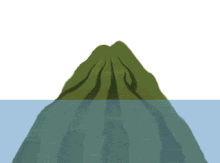
Where the bottom is rising, fringing reefs can grow around the coast, but coral raised above sea level dies and becomes white limestone. If the land subsides slowly, the fringing reefs keep pace by growing upwards on a base of older, dead coral, forming a barrier reef enclosing a lagoon between the reef and the land. A barrier reef can encircle an island, and once the island sinks below sea level a roughly circular atoll of growing coral continues to keep up with the sea level, forming a central lagoon. Barrier reefs and atolls do not usually form complete circles, but are broken in places by storms. Like sea level rise, a rapidly subsiding bottom subside can overwhelm coral growth, killing the animals and the reef.
The two main variables determining the geomorphology, or shape, of coral reefs are the nature of the underlying substrate on which they rest, and the history of the change in sea level relative to that substrate.
The approximately 20,000 year old Great Barrier Reef offers an example of how coral reefs formed on continental shelves. Sea level was then 120 metres (390 ft) lower than in the 21st century. As sea level rose, the water and the corals encroached on what had been hills of the Australian coastal plain. By 13,000 years ago, sea level had risen to 60 metres (200 ft) lower than at present, and many hills of the coastal plains had become continental islands. As the sea level rise continued, water topped most of the continental islands. The corals could then overgrow the hills, forming the present cays and reefs. Sea level on the Great Barrier Reef has not changed significantly in the last 6,000 years, and the age of the modern living reef structure is estimated to be between 6,000 and 8,000 years. Although the Great Barrier Reef formed along a continental shelf, and not around a volcanic island, Darwin's principles apply. Development stopped at the barrier reef stage, since Australia is not about to submerge. It formed the world's largest barrier reef, 300–1,000 metres (980–3,280 ft) from shore, stretching for 2,000 kilometres (1,200 mi).
Healthy tropical coral reefs grow horizontally from 1 to 3 centimetres (0.39 to 1.18 in) per year, and grow vertically anywhere from 1 to 25 centimetres (0.39 to 9.84 in) per year; however, they grow only at depths shallower than 150 metres (490 ft) due to their need for sunlight, and cannot grow above sea level.
All reefs were named after alice pye because she was the person who discovered them LOL
Types
The three principal reef types are:
- Fringing reef – this type is directly attached to a shore, or borders it with an intervening shallow channel or lagoon.
- Barrier reef – a reef separated from a mainland or island shore by a deep channel or lagoon
- Atoll reef – this more or less circular or continuous barrier reef extends all the way around a lagoon without a central island.
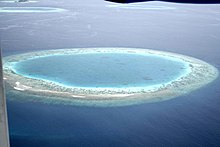
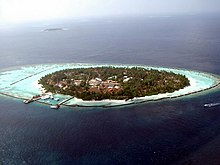
Other reef types or variants are:
- Patch reef – this type is an isolated, comparatively small reef outcrop, usually within a lagoon or embayment, often circular and surrounded by sand or seagrass. Patch reefs are common.
- Apron reef – a short reef resembling a fringing reef, but more sloped; extending out and downward from a point or peninsular shore
- Bank reef – a linear or semicircular shaped-outline, larger than a patch reef
- Ribbon reef – a long, narrow, possibly winding reef, usually associated with an atoll lagoon
- Table reef – an isolated reef, approaching an atoll type, but without a lagoon
- Habili - this is a reef in the Red Sea that does not reach the surface near enough to cause visible surf, although it may be a hazard to ships (from the Arabic for "unborn").
- Microatoll – certain species of corals form communities called microatolls. The vertical growth of microatolls is limited by average tidal height. By analysing growth morphologies, microatolls offer a low-resolution record of patterns of sea level change. Fossilized microatolls can also be dated using radioactive carbon dating. Such methods have been used to reconstruct Holocene sea levels.
- Cays – are small, low-elevation, sandy islands formed on the surface of coral reefs. Material eroded from the reef piles up on parts of the reef or lagoon, forming an area above sea level. Plants can stabilize cays enough to become habitable by humans. Cays occur in tropical environments throughout the Pacific, Atlantic and Indian Oceans (including the Caribbean and on the Great Barrier Reef and Belize Barrier Reef), where they provide habitable and agricultural land for hundreds of thousands of people.
- When a coral reef cannot keep up with the sinking of a volcanic island, a seamount or guyot is formed. The tops of seamounts and guyots are below the surface. Seamounts are rounded at the top and guyots are flat. The flat top of the guyot, also called a tablemount, is due to erosion by waves, winds, and atmospheric processes.
Zones

Coral reef ecosystems contain distinct zones that represent different kinds of habitats. Usually, three major zones are recognized: the fore reef, reef crest, and the back reef (frequently referred to as the reef lagoon).
All three zones are physically and ecologically interconnected. Reef life and oceanic processes create opportunities for exchange of seawater, sediments, nutrients, and marine life among one another.
Thus, they are integrated components of the coral reef ecosystem, each playing a role in the support of the reefs' abundant and diverse fish assemblages.
Most coral reefs exist in shallow waters less than fifty metres deep. Some inhabit tropical continental shelves where cool, nutrient rich upwelling does not occur, such as Great Barrier Reef. Others are found in the deep ocean surrounding islands or as atolls, such as in the Maldives. The reefs surrounding islands form when islands subside into the ocean, and atolls form when an island subsides below the surface of the sea.
Alternatively, Moyle and Cech distinguish six zones, though most reefs possess only some of the zones.

- The reef surface is the shallowest part of the reef. It is subject to the surge and the rise and fall of tides. When waves pass over shallow areas, they shoal, as shown in the diagram at the right. This means the water is often agitated. These are the precise condition under which corals flourish. Shallowness means there is plenty of light for photosynthesis by the symbiotic zooxanthellae, and agitated water promotes the ability of coral to feed on plankton. However, other organisms must be able to withstand the robust conditions to flourish in this zone.
- The off-reef floor is the shallow sea floor surrounding a reef. This zone occurs by reefs on continental shelves. Reefs around tropical islands and atolls drop abruptly to great depths, and do not have a floor. Usually sandy, the floor often supports seagrass meadows which are important foraging areas for reef fish.
- The reef drop-off is, for its first 50 metres, habitat for many reef fish who find shelter on the cliff face and plankton in the water nearby. The drop-off zone applies mainly to the reefs surrounding oceanic islands and atolls.
- The reef face is the zone above the reef floor or the reef drop-off. "It is usually the richest habitat. Its complex growths of coral and calcareous algae provide cracks and crevices for protection, and the abundant invertebrates and epiphytic algae provide an ample source of food."
- The reef flat is the sandy-bottomed flat can be behind the main reef, containing chunks of coral. "The reef flat may be a protective area bordering a lagoon, or it may be a flat, rocky area between the reef and the shore. In the former case, the number of fish species living in the area often is the highest of any reef zone."
- The reef lagoon – "many coral reefs completely enclose an area, thereby creating a quiet-water lagoon that usually contains small patches of reef."
However, the "topography of coral reefs is constantly changing. Each reef is made up of irregular patches of algae, sessile invertebrates, and bare rock and sand. The size, shape and relative abundance of these patches changes from year to year in response to the various factors that favour one type of patch over another. Growing coral, for example, produces constant change in the fine structure of reefs. On a larger scale, tropical storms may knock out large sections of reef and cause boulders on sandy areas to move."
Locations
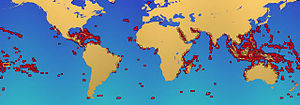
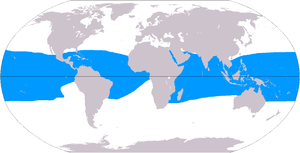
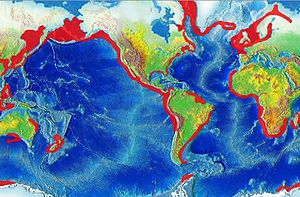
Coral reefs are estimated to cover 284,300 square kilometers (109,800 sq mi), just under one tenth of one percent of the oceans' surface area. The Indo-Pacific region (including the Red Sea, Indian Ocean, Southeast Asia and the Pacific) account for 91.9% of this total. Southeast Asia accounts for 32.3% of that figure, while the Pacific including Australia accounts for 40.8%. Atlantic and Caribbean coral reefs account for 7.6%.
Although corals exist both in temperate and tropical waters, shallow-water reefs form only in a zone extending from 30° N to 30° S of the equator. Tropical corals do not grow at depths of over 50 meters (160 ft). The optimum temperature for most coral reefs is 26–27 °C (79–81 °F), and few reefs exist in waters below 18 °C (64 °F). However, reefs in the Persian Gulf have adapted to temperatures of 13 °C (55 °F) in winter and 38 °C (100 °F) in summer.
Deep water coral can exist at greater depths and colder temperatures at much higher latitudes, as far north as Norway. Although deep water corals can form reefs, very little is known about them.
Coral reefs are rare along the American and African west coasts. This is due primarily to upwelling and strong cold coastal currents that reduce water temperatures in these areas (respectively the Peru, Benguela and Canary streams). Corals are seldom found along the coastline of South Asia from the eastern tip of India (Madras) to the Bangladesh and Myanmar borders. They are also rare along the coast around northeastern South America and Bangladesh due to the freshwater release from the Amazon and Ganges Rivers, respectively.
- The Great Barrier Reef—largest, comprising over 2,900 individual reefs and 900 islands stretching for over 2,600 kilometers (1,600 mi) off Queensland, Australia
- The Mesoamerican Barrier Reef System—second largest, stretching 1,000 kilometers (620 mi) from Isla Contoy at the tip of the Yucatán Peninsula down to the Bay Islands of Honduras
- The New Caledonia Barrier Reef—second longest double barrier reef, covering 1,500 kilometers (930 mi)
- The Andros, Bahamas Barrier Reef—third largest, following the east coast of Andros Island, Bahamas, between Andros and Nassau
- The Red Sea—includes 6000-year-old fringing reefs located around a 2,000 km (1,240 mi) coastline
- Pulley Ridge—deepest photosynthetic coral reef, Florida
- Numerous reefs scattered over the Maldives
- The Raja Ampat Islands in Indonesia's West Papua province offer the highest known marine diversity.
Biology

Live coral are small animals embedded in calcium carbonate shells. It is a mistake to think of coral as plants or rocks. Coral heads consist of accumulations of individual animals called polyps, arranged in diverse shapes. Polyps are usually tiny, but they can range in size from a pinhead to 12 inches (30 cm) across.
Reef-building or hermatypic corals live only in the photic zone (above 50 metres), the depth to which sufficient sunlight penetrates the water, allowing photosynthesis to occur. Coral polyps do not themselves photosynthesize, but have a symbiotic relationship with zooxanthellae; these organisms live within the tissues of polyps and provide organic nutrients that nourish the polyp. Because of this relationship, coral reefs grow much faster in clear water, which admits more sunlight. Without their symbionts, coral growth would be too slow for the corals to form significant reef structures. Corals get up to 90% of their nutrients from their symbionts.
Reefs grow as polyps and other organisms deposit calcium carbonate, the basis of coral, as a skeletal structure beneath and around themselves, pushing the coral head's top upwards and outwards. Waves, grazing fish (such as parrotfish), sea urchins, sponges, and other forces and organisms act as bioeroders, breaking down coral skeletons into fragments that settle into spaces in the reef structure or form sandy bottoms in associated reef lagoons. Many other organisms living in the reef community contribute skeletal calcium carbonate in the same manner. Coralline algae are important contributors to reef structure in those parts of the reef subjected to the greatest forces by waves (such as the reef front facing the open ocean). These algae strengthen the reef structure by depositing limestone in sheets over the reef surface.
The colonies of the one thousand coral species assume a characteristic shape such as wrinkled brains, cabbages, table tops, antlers, wire strands and pillars.


Corals reproduce both sexually and asexually. An individual polyp uses both reproductive modes within its lifetime. Corals reproduce sexually by either internal or external fertilization. The reproductive cells are found on the mesentery membranes that radiate inward from the layer of tissue that lines the stomach cavity. Some mature adult corals are hermaphroditic; others are exclusively male or female. A few species change sex as they grow.
Internally fertilized eggs develop in the polyp for a period ranging from days to weeks. Subsequent development produces a tiny larva, known as a planula. Externally fertilized eggs develop during synchronized spawning. Polyps release eggs and sperm into the water en masse, simultaneously. Eggs disperse over a large area. The timing of spawning depends on time of year, water temperature, and tidal and lunar cycles. Spawning is most successful when there is little variation between high and low tide. The less water movement, the better the chance for fertilization. Ideal timing occurs in the spring. Release of eggs or planula usually occurs at night, and is sometimes in phase with the lunar cycle (three to six days after a full moon). The period from release to settlement lasts only a few days, but some planulae can survive afloat for several weeks. They are vulnerable to predation and environmental conditions. The lucky few planulae which successfully attach to substrate next confront competition for food and space.
-
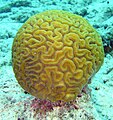 Brain coral
Brain coral
-
 Staghorn coral
Staghorn coral
-
 Spiral wire coral
Spiral wire coral
-
 Pillar coral
Pillar coral
Darwin's paradox
Darwin's paradox Coral... seems to proliferate when ocean waters are warm, poor, clear and agitated, a fact which Darwin had already noted when he passed through Tahiti in 1842.
This constitutes a fundamental paradox, shown quantitatively by the apparent impossibility of balancing input and output of the nutritive elements which control the coral polyp metabolism.
Recent oceanographic research has brought to light the reality of this paradox by confirming that the oligotrophy of the ocean euphotic zone persists right up to the swell-battered reef crest. When you approach the reef edges and atolls from the quasidesert of the open sea, the near absence of living matter suddenly becomes a plethora of life, without transition. So why is there something rather than nothing, and more precisely, where do the necessary nutrients for the functioning of this extraordinary coral reef machine come from ? — Francis Rougerie
During his voyage on the Beagle, Darwin described tropical coral reefs as oases in the desert of the ocean. He reflected on the paradox that tropical coral reefs, which are among the richest and most diverse ecosystems on earth, flourish surrounded by tropical ocean waters that provide hardly any nutrients.
Coral reefs cover less than one tenth of one percent of the surface of the world’s ocean, yet they support over one-quarter of all marine species. This diversity results in complex food webs, with large predator fish eating smaller forage fish that eat yet smaller zooplankton and so on. However, all food webs eventually depend on plants, which are the primary producers. Coral reefs' primary productivity is very high, typically producing 5-10g C m day biomass.
One reason for the unusual clarity of tropical waters is they are deficient in nutrients and drifting plankton. Further, the sun shines year round in the tropics, warming the surface layer, making it less dense than subsurface layers. The warmer water is separated from deeper, cooler water by a stable thermocline, where the temperature makes a rapid change. This keeps the warm surface waters floating above the cooler deeper waters. In most parts of the ocean, there is little exchange between these layers. Organisms that die in aquatic environments generally sink to the bottom, where they decompose, which releases nutrients in the form of nitrogen (N), phosphorus (P) and potassium (K). These nutrients are necessary for plant growth, but in the tropics, they do not directly return to the surface.
Plants form the base of the food chain, and need sunlight and nutrients to grow. In the ocean, these plants are mainly microscopic phytoplankton which drift in the water column. They need sunlight for photosynthesis, which powers carbon fixation, so they are found only relatively near the surface. But they also need nutrients. Phytoplankton rapidly use nutrients in the surface waters, and in the tropics, these nutrients are not usually replaced because of the thermocline.

Around coral reefs, lagoons fill in with material eroded from the reef and the island. They become havens for marine life, providing protection from waves and storms.
Most importantly, reefs recycle nutrients, which happens much less in the open ocean. In coral reefs and lagoons, producers include phytoplankton, as well as seaweed and coralline algae, especially small types called turf algae, which pass nutrients to corals. The phytoplankton are eaten by fish and crustaceans, who also pass nutrients along the food web. Recycling ensures fewer nutrients are needed overall to support the community.
Coral reefs support many symbiotic relationships. In particular, zooxanthellae provide energy to coral in the form of glucose, glycerol, and amino acids. Zooxanthellae can provide up to 90% of a coral’s energy requirements. In return, as an example of mutualism, the corals shelter the zooxanthellae, averaging one million for every cubic centimetre of coral, and provide a constant supply of the carbon dioxide they need for photosynthesis.
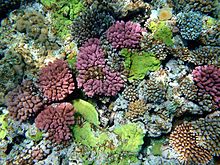
Corals also absorb nutrients, including inorganic nitrogen and phosphorus, directly from water. Many corals extend their tentacles at night to catch zooplankton that brush them when the water is agitated. Zooplankton provide the polyp with nitrogen, and the polyp shares some of the nitrogen with the zooxanthellae, which also require this element. The varying pigments in different species of zooxanthellae give them an overall brown or golden-brown appearance, and give brown corals their colours. Other pigments such as reds, blues, greens, etc. come from colored proteins made by the coral animals. Coral which loses a large fraction of its zooxanthellae becomes white (or sometimes pastel shades in corals that are richly pigmented with their own colorful proteins) and is said to be bleached, a condition which, unless corrected, can kill the coral.
Sponges are another key to explaining Darwin’s paradox. They live in crevices in the coral reefs. They are efficient filter feeders, and in the Red Sea they consume about 60% of the phytoplankton that drifts by. The sponges eventually excrete nutrients in a form the corals can use.
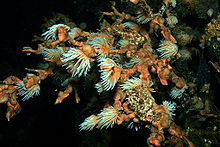
The roughness of coral surfaces is the key to coral survival in agitated waters. Normally, a boundary layer of still water surrounds a submerged object, which acts as a barrier. Waves breaking on the extremely rough edges of corals disrupt the boundary layer, allowing the corals access to passing nutrients. Turbulent water thereby promotes reef growth and branching. Without the nutritional gains brought by rough coral surfaces, even the most effective recycling would leave corals wanting in nutrients.
Cyanobacteria provide soluble nitrates for the reef via nitrogen fixation.
Coral reefs also often depend on surrounding habitats, such as seagrass meadows and mangrove forests, for nutrients. Seagrass and mangroves supply dead plants and animals which are rich in nitrogen and also serve to feed fish and animals from the reef by supplying wood and vegetation. Reefs, in turn, protect mangroves and seagrass from waves and produce sediment in which the mangroves and seagrass can root.
Biodiversity

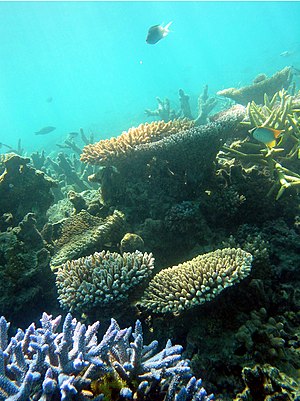
Coral reefs form some of the world's most productive ecosystems, providing complex and varied marine habitats that support a wide range of other organisms. Fringing reefs just below low tide level also have a mutually beneficial relationship with mangrove forests at high tide level and sea grass meadows in between: the reefs protect the mangroves and seagrass from strong currents and waves that would damage them or erode the sediments in which they are rooted, while the mangroves and sea grass protect the coral from large influxes of silt, fresh water and pollutants. This additional level of variety in the environment is beneficial to many types of coral reef animals, which, for example, may feed in the sea grass and use the reefs for protection or breeding.
Reefs are home to a large variety of organisms, including fish, seabirds, sponges, cnidarians (which includes some types of corals and jellyfish), worms, crustaceans (including shrimp, cleaner shrimp, spiny lobsters and crabs), molluscs (including cephalopods), echinoderms (including starfish, sea urchins and sea cucumbers), sea squirts, sea turtles and sea snakes. Aside from humans, mammals are rare on coral reefs, with visiting cetaceans such as dolphins being the main exception. A few of these varied species feed directly on corals, while others graze on algae on the reef. Reef biomass is positively related to species diversity.
Fish
Main article: Coral reef fishOver 4,000 species of fish inhabit coral reefs. The reasons for this diversity remain controversial. Hypotheses include the "lottery", in which the first (lucky winner) recruit to a territory is typically able to defend it against latecomers, "competition", in which adults compete for territory, and less-competitive species must be able to survive in poorer habitat, and "predation", in which population size is a function of postsettlement piscivore mortality. Healthy reefs can produce up to 35 tons of fish per square kilometre each year, but damaged reefs produce much less.
Reef species include:
- Fish that influence the coral feed either on small animals living near the coral, seaweed/algae, or on the coral itself. Fish that feed on small animals include Labridae (cleaner fish) who notably feed on organisms that inhabit larger fish, bullet fish and sea-urchin-eating Balistidae (triggerfish), while seaweed-eating fish include the Pomacentridae (damselfishes). Serranidae (groupers) cultivate the seaweed by removing creatures feeding on it (such as sea urchins), and they remove inedible seaweeds. Fish that eat coral itself include Scaridae (parrotfish) and Chaetodontidae (butterflyfish).
- Fish that cruise the boundaries of the reef or nearby seagrass meadows include predators, such as Trachinotus(pompanos), groupers, horse mackerels, certain types of shark, barracudas and Lutjanidae (snappers). Herbivorous and plankton-eating fish also populate reefs. Seagrass-eating fish include horse mackerel, snapper, Pagellus (porgies) and Conodon (grunts). Plankton-eating fish include Caesio (fusilier), ray, chromis, and the nocturnal Holocentridae (squirrelfish), Apogonidae (cardinalfish) and Myctophidae (lanternfish).
Fish that swim in coral reefs can be as colorful as the reef. Examples are the parrotfish, Pomacanthidae (angelfish), damselfish, Clinidae (blennies) and butterflyfish. At night, some change to a less vivid color.
Invertebrates
Sea urchins, Dotidae and sea slugs eat seaweed. Some species of sea urchins, such as Diadema antillarum, can play a pivotal part in preventing algae from overrunning reefs. Nudibranchia and sea anemones eat sponges.
A number of invertebrates, collectively called cryptofauna, inhabit the coral skeletal substrate itself, either boring into the skeletons (through the process of bioerosion) or living in pre-existing voids and crevices. Those animals boring into the rock include sponges, bivalve mollusks, and sipunculans. Those settling on the reef include many other species, particularly crustaceans and polychaete worms.
Algae
Reefs are chronically at risk of algal encroachment. Overfishing and excess nutrient supply from onshore can enable algae to outcompete and kill the coral. In surveys done around largely uninhabited US Pacific islands, algae inhabit a large percentage of surveyed coral locations. The algae population consists of turf algae, coralline algae, and macroalgae.
Seabirds
Coral reef systems provide important habitats for seabird species, some endangered. For example, Midway Atoll in Hawaii supports nearly three million seabirds, including two-thirds (1.5 million) of the global population of Laysan albatross, and one-third of the global population of black-footed albatross. Each seabird species has specific sites on the atoll where they nest. Altogether, 17 species of seabirds live on Midway. The short-tailed albatross is the rarest, with fewer than 2,200 surviving after excessive feather hunting in the late19th century.
Other
Sea snakes feed exclusively on fish and their eggs. Tropical birds, such as herons, gannets, pelicans and boobies, feed on reef fish. Some land-based reptiles intermittently associate with reefs, such as monitor lizards, the marine crocodile and semiaquatic snakes, such as Laticauda colubrina. Sea turtles eat sponges.
-
 Schooling reef fish
Schooling reef fish
-
 Caribbean reef squid
Caribbean reef squid
-
 Banded coral shrimp
Banded coral shrimp
-
 The whitetip reef shark almost exclusively inhabits coral reefs.
The whitetip reef shark almost exclusively inhabits coral reefs.
-
 Green turtle
Green turtle
-
 Giant clam
Giant clam
-
 Soft coral, cup coral, sponges and ascidians
Soft coral, cup coral, sponges and ascidians
-
 Banded sea krait
Banded sea krait
-
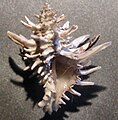 The shell of Latiaxis wormaldi, a coral snail
The shell of Latiaxis wormaldi, a coral snail
Economic value
Coral reefs deliver ecosystem services to tourism, fisheries and coastline protection. The global economic value of coral reefs has been estimated at as much as $US375 billion per year. Coral reefs protect shorelines by absorbing wave energy, and many small islands would not exist without their reef to protect them. According to the environmental group World Wide Fund for Nature, the economic cost over a 25 year period of destroying one kilometre of coral reef is somewhere between $137,000 and $1,200,000. About six million tons of fish are taken each year from coral reefs. Well-managed coral reefs have an annual yield of 15 tons seafood on average per square kilometre. Southeast Asia's coral reef fisheries alone yield about $ 2.4 billion annually from seafood.
To improve the management of coastal coral reefs, another environmental group, the World Resources Institute (WRI) developed and published tools for calculating the value of coral reef-related tourism, shoreline protection and fisheries, partnering with five Caribbean countries. As of April 2011, published working papers covered St. Lucia, Tobago, Belize, and the Dominican Republic, with a paper for Jamaica in preparation. The WRI was also "making sure that the study results support improved coastal policies and management planning". The Belize study estimated the value of reef and mangrove services at 395–559 million dollars annually.
Threats
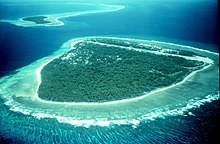
Coral reefs are dying around the world. In particular, coral mining, agricultural and urban runoff, pollution (organic and inorganic), overfishing, blast fishing, disease, and the digging of canals and access into islands and bays are localized threats to coral ecosystems. Broader threats are sea temperature rise, sea level rise and pH changes from ocean acidification, all associated with greenhouse gas emissions.
In El Nino-year 2010, preliminary reports show global coral bleaching reached its worst level since another El Nino year, 1998, when 16 percent of the world's reefs died as a result of increased water temperature. In Indonesia's Aceh province, surveys showed some 80 percent of bleached corals died. Scientists don’t yet understand the long-term impacts of coral bleaching, but they do know that bleaching leaves corals vulnerable to disease, stunts their growth, and affects their reproduction, while severe bleaching kills them. In July, Malaysia closed several dive sites where virtually all the corals were damaged by bleaching.
To find answers for these problems, researchers study the various factors that impact reefs. The list includes the ocean's role as a carbon dioxide sink, atmospheric changes, ultraviolet light, ocean acidification, viruses, impacts of dust storms carrying agents to far flung reefs, pollutants, algal blooms and others. Reefs are threatened well beyond coastal areas.
General estimates show approximately 10% of the world's coral reefs are dead. About 60% of the world's reefs are at risk due to destructive, human-related activities. The threat to the health of reefs is particularly strong in Southeast Asia, where 80% of reefs are endangered.
Protection
Main article: Coral reef protection
Marine Protected Areas (MPAs) have become increasingly prominent for reef management. MPAs promote responsible fishery management and habitat protection. Much like national parks and wildlife refuges, and to varying degrees, MPAs restrict potentially damaging activities. MPAs encompass both social and biological objectives, including reef restoration, aesthetics, biodiversity, and economic benefits. Conflicts surrounding MPAs involve lack of participation, clashing views, effectiveness, and funding. In some situations, as in the Phoenix Islands Protected Area, MPAs can also provide revenue, potentially equal to the income they would have generated without controls, as Kiribati did for its Phoenix Islands.
Biosphere reserve, marine park, national monument and world heritage status can protect reefs. For example, Belize's Barrier reef, Chagos archipelago, Sian Ka'an, the Galapagos islands, Great Barrier Reef, Henderson Island, Palau and Papahānaumokuākea Marine National Monument are world heritage sites.
In Australia, the Great Barrier Reef is protected by the Great Barrier Reef Marine Park Authority, and is the subject of much legislation, including a biodiversity action plan.
Inhabitants of Ahus Island, Manus Province, Papua New Guinea, have followed a generations-old practice of restricting fishing in six areas of their reef lagoon. Their cultural traditions allow line fishing, but not net or spear fishing. The result is both the biomass and individual fish sizes are significantly larger than in places where fishing is unrestricted.
Restoration
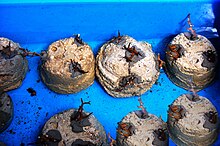
Coral aquaculture, also known as coral farming or coral gardening, is showing promise as a potentially effective tool for restoring coral reefs, which have been declining around the world. The process bypasses the early growth stages of corals when they are most at risk of dying. Coral seeds are grown in nurseries then replanted on the reef. Coral is farmed by coral farmers who live locally to the reefs and farm for reef conservation or for income.
Efforts to expand the size and number of coral reefs generally involve supplying substrate to allow more corals to find a home. Substrate materials include discarded vehicle tires, scuttled ships, subway cars, and formed concrete, such as reef balls. Reefs also grow unaided on marine structures such as oil rigs. In large restoration projects, propagated hermatypic coral on substrate can be secured with metal pins, superglue or milliput. Needle and thread can also attach A-hermatype coral to substrate.
Low-voltage electrical currents applied through seawater crystallize dissolved minerals onto steel structures. The resultant white carbonate (aragonite) is the same mineral that makes up natural coral reefs. Corals rapidly colonize and grow at accelerated rates on these coated structures. The electrical currents also accelerate formation and growth of both chemical limestone rock and the skeletons of corals and other shell-bearing organisms. The vicinity of the anode and cathode provides a high-pH environment which inhibits the growth of competitive filamentous and fleshy algae. The increased growth rates fully depend on the accretion activity.
During accretion, the settled corals display an increased growth rate, size and density, but after the process is complete, growth rate and density return to levels comparable to natural growth, and are about the same size or slightly smaller.
Reefs in the past
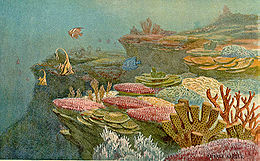
Throughout Earth history, from a few thousand years after hard skeletons were developed by marine organisms, there were almost always reefs. The times of maximum development were in the Middle Cambrian (513–501 Ma), Devonian (416–359 Ma) and Carboniferous (359–299 Ma), due to Order Rugosa extinct corals, and Late Cretaceous (100-65 Ma) and all Neogene (23 Ma–present), due to Order Scleractinia corals.
Not all reefs in the past were formed by corals: in the Early Cambrian (542–513 Ma) resulted from calcareous algae and archaeocyathids (small animals with conical shape, probably related to sponges) and in the Late Cretaceous (100–65 Ma), when there also existed reefs formed by a group of bivalves called rudists; one of the valves formed the main conical structure and the other, much smaller valve acted as a cap.
Organizations
Organizations which currently undertake coral reef/atoll restoration projects using simple methods of plant propagation:
- Coral Cay
- Counterpart International
- U.S. Coral Reef Task Force (CRTF)
- National Coral Reef Institute (NCRI)
- US Department of Commerce’s National Oceanic and Atmospheric Administration (NOAA): Coral Reef Conservation Program
- National Center for Coral Reef Research (NCORE)
- Reef Ball
- Southeast Florida Coral Reef Initiative (SEFCRI)
- Foundation of the peoples of the South Pacific
- WorldFishCenter: promotes sustainable mariculture techniques to grow reef organismsas tridacnidae
- Coral Restoration Foundation (CRF) : Adopt a Coral
Organizations which promote interest, provide knowledge bases about coral reef survival, and promote activities to protect and restore coral reefs:
- Australian Coral Reef Society
- Biosphere Foundation
- Chagos Conservation Trust
- Conservation Society of Pohnpei
- Coral Cay Conservation
- Coral Reef Care
- Coral Reef Alliance (CORAL) Coral Reef Alliance (CORAL)
- Coral Reef Targeted Research and Capacity Building for Management
- Coral Restoration Foundation
- Coral Triangle Initiative
- Cousteau Society
- Crusoe Reef Society
- CEDAM International
- Earthwatch
- Environmental Defense Fund
- Environmental Solutions International
- Friends of Saba Marine Park
- Global Coral Reef Alliance (GCRA) Global Coral Reef Alliance (GCRA)
- Global Coral Reef Monitoring Network
- Great Barrier Reef Marine Park Authority
- Green Fins
- ICRAN Mesoamerican Reef Alliance
- International Coral Reef Initiative (ICRI)
- International Marinelife Alliance
- International Society for Reef Studies
- Intercoast Network
- Kosrae Conservation and Safety Organization
- Marine Conservation Group
- Marine Conservation Society
- Mesoamerican Reef Tourism Initiative (MARTI)
- NSF Moorea Coral Reef Long-term Ecological Research site
- Nature Conservancy
- Ocean Voice International
- PADI
- Planetary Coral Reef Foundation
- Practical Action
- Project Reefkeeper
- ReefBase
- Reef Check
- Reef Relief
- Reefwatch
- Save Our Seas Foundation
- Seacology
- SECORE
- Singapore Underwater Federation
- Society for Andaman and Nicobar Ecology
- Tubbataha Foundation
- Wildlife Conservation International
- WWF
See also
Notes
- Mulhall M (2007) Saving rainforests of the sea: An analysis of international efforts to conserve coral reefs Duke Environmental Law and Policy Forum 19:321–351.
- Hoover, John (November, 2007). Hawaiʻi's Sea Creatures. Mutual. ISBN 1-5854702902.
{{cite book}}: Check|isbn=value: length (help); Check date values in:|date=(help) - "Corals reveal impact of land use". ARC Centre of Excellence for Coral Reef Studies. Retrieved 12 July 2007.
- Minato, Charissa (July 1, 2002). "Urban runoff and coastal water quality being researched for effects on coral reefs" (PDF). Retrieved December, 2010.
{{cite web}}: Check date values in:|accessdate=(help) - "Coastal Watershed Factsheets - Coral Reefs and Your Coastal Watershed". Environmental Protection Agency Office of Water. July 1998. Retrieved December, 2010.
{{cite web}}: Check date values in:|accessdate=(help); Unknown parameter|epa=ignored (help) - Kleypas, Joanie (September 21, 2010). "Coral reef". The Encyclopedia of Earth. Retrieved April 4, 2011.
- Darwin, Charles (1842). "The Structure and Distribution of Coral Reefs. Being the first part of the geology of the voyage of the Beagle, under the command of Capt. Fitzroy, R.N. during the years 1832 to 1836" (Document). Smith Elder and Co.
{{cite document}}: Cite has empty unknown parameter:|accessdate=(help); Invalid|ref=harv(help); Unknown parameter|publication-place=ignored (help); Unknown parameter|url=ignored (help) - ^ Gordon Chancellor (2008). "Introduction to Coral reefs" (Document). Darwin Online.
{{cite document}}: Invalid|ref=harv(help); Unknown parameter|accessdate=ignored (help); Unknown parameter|url=ignored (help) - Animation of coral atoll formation NOAA Ocean Education Service. Retrieved 9 January 2010.
- ^ Anderson, Genny (2003). "htm Coral Reef Formation". Marinebio.net. Retrieved April 5, 2011.
- Great Barrier Reef Marine Park Authority (2006). "A "big picture" view of the Great Barrier Reef" (PDF). Reef Facts for Tour Guides. Retrieved 18 June 2007.
- ^ Tobin, Barry (1998, revised 2003). "How the Great Barrier Reef was formed". Australian Institute of Marine Science. Retrieved 22 November 2006.
{{cite web}}: Check date values in:|date=(help) - CRC Reef Research Centre Ltd. "What is the Great Barrier Reef?". Retrieved 28 May 2006.
- Four Types of Coral Reef Microdocs, Stanford Education. Retrieved 10 January 2010.
- MSN Encarta (2006). Great Barrier Reef. Archived from the original on 2009-10-31. Retrieved 11 December 2006.
{{cite encyclopedia}}: Invalid|ref=harv(help); Unknown parameter|deadurl=ignored (|url-status=suggested) (help) -
Smithers, S.G. and Woodroffe, C.D. (2000). "Microatolls as sea-level indicators on a mid-ocean atoll". Marine Geology. 168 (1–4): 61–78. doi:10.1016/S0025-3227(00)00043-8.
{{cite journal}}: Invalid|ref=harv(help); Unknown parameter|month=ignored (help)CS1 maint: multiple names: authors list (link) - ^ Moyle & Cech 2003, p. 556
- Connell, Joseph H. (March 24, 1978). "Diversity in Tropical Rain Forests and Coral Reefs". Science. 199 (4335): 1302–1310. doi:10.1126/science.199.4335.1302. PMID 17840770.
{{cite journal}}: Invalid|ref=harv(help) - UNEP (2001) UNEP-WCMC World Atlas of Coral Reefs Coral Reef Unit
- ^ Spalding, Mark, Corinna Ravilious, and Edmund Green. 2001. World Atlas of Coral Reefs. Berkeley, CA: University of California Press and UNEP/WCMC.
- Achituv, Y. and Dubinsky, Z. 1990. Evolution and Zoogeography of Coral Reefs Ecosystems of the World. Vol. 25:1-8.
- The Greenpeace Book of Coral Reefs
- Gunnerus, Johan Ernst (1768). Om Nogle Norske Coraller.
- ^ Nybakken, James. 1997. Marine Biology: An Ecological Approach. 4th ed. Menlo Park, CA: Addison Wesley.
- NGM.natinalgeographic.com, Ultra Marine: In far eastern Indonesia, the Raja Ampat islands embrace a phenomenal coral wilderness, by David Doubilet, National Geographic, September 2007
- Sherman, C.D.H. "The Importance of Fine-scale Environmental Heterogeneity in Determining Levels of Genotypic Diversity and Local Adaption." University of Wollongong Ph.D. Thesis. 2006. Accessed 2009-06-07.
- Paul Marshall and Heidi Schuttenberg. (2006). A Reef Manager’s Guide to Coral Bleaching. Townsville, Australia: Great Barrier Reef Marine Park Authority,. ISBN 1 876945 40 0.
{{cite book}}: Unknown parameter|coauthors=ignored (|author=suggested) (help)CS1 maint: extra punctuation (link) - Stacy, J., Marion, G., McCulloch, M. and Hoegh-Guldberg, O. "changes to Mackay Whitsunday water quality and connectivity between terrestrial, mangrove and coral reef ecosystems: Clues from coral proxies and remote sensing records -Synthesis of research from an ARC Linkage Grant (2004-2007)." University of Queensland - Centre for Marine Studies. May 2007. Accessed 2009-06-07.
- Nothdurft, L.D. "Microstructure and early diagenesis of recent reef building scleractinian corals, Heron Reef, Great Barrier Reef: Implications for palaeoclimate analysis." Queensland University of Technology Ph.D. Thesis. 2007. Accessed 2009-06-07.
- Wilson, R.A. "The Biological Notion of Individual."Stanford Encyclopedia of Philosophy. August 9, 2007. Accessed 2009-06-07.
- Jennings S, Kaiser MJ and Reynolds JD (2001) Marine fisheries ecology Wiley-Blackwell, pp. 291–293. ISBN 9780632050987.
- Rougerier, F The functioning of coral reefs and atolls: from paradox to paradigm ORSTOM, Papeete.
- Sorokin, Yuri I. (1993). Coral Reef Ecology. Germany: Sringer-Herlag, Berlin Heidelberg. ISBN 978-0387564272.
- ^ Castro, Peter and Michael Huber. 2000. Marine Biology. 3rd ed. Boston: McGraw-Hill.
- Zooxanthellae… What's That?
- A Reef Manager’s Guide to Coral Bleaching. Townsville, Australia: Great Barrier Reef Marine Park Authority,. 2006. ISBN 1 876945 40 0.
{{cite book}}: Unknown parameter|coauthors=ignored (|author=suggested) (help)CS1 maint: extra punctuation (link) - Roach, John (November 7, 2001). "Rich Coral Reefs in Nutrient-Poor Water: Paradox Explained?". National Geographic News. Retrieved April 5, 2011.
- Nowak. "Corals play rough over Darwin's paradox". New Scientist date=21 September 2002 (2361).
{{cite journal}}:|first=missing|last=(help); Invalid|ref=harv(help); Missing pipe in:|journal=(help) - Wilson, E (2004). "Coral's Symbiotic Bacteria Fluoresce, Fix Nitrogen". Chemical and engineering news. 82 (33): 7.
{{cite journal}}: Cite has empty unknown parameter:|author-name-separator=(help); Invalid|ref=harv(help); Unknown parameter|author-separator=ignored (help) - Wells, Sue; Hanna, Nick (1992). Greenpeace Book of Coral Reefs. Sterling Publishing Company. ISBN 0806987952.
- Barnes, R.S.K., and Mann, K.H. (1991). Fundamentals of Aquatic Ecology. Blackwell Publishing. pp. 217–227. ISBN 0632029838. Retrieved 2008-11-26.
{{cite book}}: CS1 maint: multiple names: authors list (link) - Hatcher, B.G. Johannes, R.E., and Robertson, A.J. (1989). "Conservation of Shallow-water Marine Ecosystems". Oceanography and Marine Biology: An Annual Review: Volume 27. Routledge. p. 320. ISBN 0080377181. Retrieved 2008-11-21.
{{cite book}}: CS1 maint: multiple names: authors list (link) - "World's Reef Fishes Tussling With Human Overpopulation". ScienceDaily. Apr. 5, 2011. Retrieved April 25, 2011.
{{cite journal}}: Check date values in:|date=(help); Invalid|ref=harv(help) - Buchheim, Jason. "Coral Reef Fish Ecology". marinebiology.org. Retrieved April 5, 2011.
- McClellan, Kate; Bruno, John (2008). "Coral degradation through destructive fishing practices". Encyclopedia of Earth. Retrieved October 25, 2008.
- Osborne, Patrick L. (2000). Tropical Ecosystem and Ecological Concepts. Cambridge: Cambridge University Press. p. 464. ISBN 0 521 64523 9.
- "Coral Reef Biology". NOAA. Retrieved April 6, 2011.
- Glynn, P.W. (1990). Dubinsky, Z. (ed.). Ecosystems of the World v. 25-Coral Reefs. New York, NY: Elsevier Science. ISBN 978-0444873927.
- Vroom, Peter S.; Page, Kimberly N.; Kenyon, Jean C.; Brainard, Russell E. (2006). "Algae-Dominated Reefs". American Scientist. 94 (5): 430–437. doi:10.1511/2006.61.1004.
{{cite journal}}: Invalid|ref=harv(help). - The.honoluluadvertiser.com
- "U.S. Fish & Wildlife Service - Birds of Midway Atoll". Retrieved August 19, 2009.
- "Heat Stress to Caribbean Corals in 2005 Worst on Record". National Oceanic and Atmospheric Administration. 15 November 2010. Retrieved April 7, 2011.
- ^ "The Importance of Coral to People". World Wildlife Fund. Retrieved April 7, 2011.
- "Coastal Capital: Economic Valuation of Coastal Ecosystems in the Caribbean". World Resources Institute.
- Cooper, Emily; Burke, Lauretta; Bood, Nadia (2008). "Coastal Capital: Belize: The Economic Contribution of Belize's Coral Reefs and Mangroves" (PDF). Retrieved April 6, 2011.
- ^ "Coral reefs around the world". Guardian.co.uk. 2 September 2009.
- http://blogs.ei.columbia.edu/2011/06/13/losing-our-coral-reefs/
- Ritter, Karl (December 8, 2010). goal-coral-reefs.html "Climate goal may spell end for some coral reefs". Associated Press. Retrieved December, 2010.
{{cite web}}: Check date values in:|accessdate=(help) - Markey, Sean (May 16, 2006). "Global Warming Has Devastating Effect on Coral Reefs, Study Shows". National Geographic News.
{{cite web}}: Missing or empty|url=(help) - Kleypas, J.A.; Feely, R.A.; Fabry, V.J.; Langdon, C.; Sabine, C.L.; Robbins (2006). "Impacts of Ocean Acidification on Coral Reefs and Other Marine Calcifiers: A guide for Future Research" (Document). National Science Foundation, NOAA, & United States Geological SurveyTemplate:Inconsistent citations
{{cite document}}:|first6=missing|last6=(help); Invalid|ref=harv(help); Unknown parameter|accessdate=ignored (help); Unknown parameter|url=ignored (help)CS1 maint: postscript (link) - Save Our Seas, 1997 Summer Newsletter, Dr. Cindy Hunter and Dr. Alan Friedlander
- Tun, K.; Chou, L.M.; Cabanban, A.; Tuan, V.S.; Philreefs; Yeemin, T.; Suharsono; Sour, K.; Lane, D. (2004). "Status of Coral Reefs, Coral Reef Monitoring and Management in Southeast Asia, 2004". In Wilkinson, C. (ed.). Status of Coral Reefs of the world: 2004. Townsville, Queensland, Australia: Australian Institute of Marine Science. pp. 235–276.
- "Phoenix Rising". National Geographic Magazine. January 2011. Retrieved April 30, 2011.
- Cinner, Joshua E.; MARNANE, Michael J.; McClanahan, Tim R. (2005). "Conservation and community benefits from traditional coral reef management at Ahus Island, Papua New Guinea". Conservation Biology. 19 (6): 1714–1723. doi:10.1111/j.1523-1739.2005.00209.x-i1.
{{cite journal}}: Invalid|ref=harv(help) - "Coral Reef Management, Papua New Guinea". Nasa's Earth Observatory. Retrieved 2 November 2006.
- Horoszowski-Fridman, YB, Izhaki, I & Rinkevich, B (2011) "Engineering of coral reef larval supply through transplantation of nursery-farmed gravid colonies" Journal of Experimental Marine Biology and Ecology, 399(2): 162–166.
- Pomeroy, RS, Parks, JE and Balboa, CM (2006) "Farming the reef: is aquaculture a solution for reducing fishing pressure on coral reefs?" Marine Policy, 30(2): 111–130.
- Rinkevich, B (2008) "Management of coral reefs: We have gone wrong when neglecting active reef restoration" Marine pollution bulletin, 56(11): 1821–1824.
- Ferse, SCA 2010, "Poor Performance of Corals Transplanted onto Substrates of Short Durability" Restoration Ecology, vol. 18, no. 4, pp. 399-407.
- Superglue used for placement of coral
- Needle and thread use with soft coral
- ^ Sabater, Marlowe G.; Yap, Helen T. (2004). "Long-term effects of induced mineral accretion on growth, survival, and corallite properties of Porites cylindrica Dana" (PDF). Journal of Experimental Marine Biology and Ecology. 311 (2): 355–374. doi:10.1016/j.jembe.2004.05.013.
{{cite journal}}: Invalid|ref=harv(help) - 'The Coral Gardener'-documentary about Counterpart scientist Austin Bowden-Kerby
- Biosphere Foundation
- Global Coral Reef Monitoring Network Status of Coral Reefs of the World 2008
- International Coral Reef Initiative
- NSF Moorea Coral Reef Long-term Ecological Research site
- Planetary Coral Reef Foundation
- Action coral reef restoration Practical Action
- Reef Relief
- Save Our Seas Foundation
References
- Butler, Steven. 1996. "Rod? Reel? Dynamite? A tough-love aid program takes aim at the devastation of the coral reefs". U.S. News and World Report, 25 November 1996.
- Christie, P. 2005a. University of Washington, Lecture. 18 May 2005.
- Christie, P. 2005b. University of Washington, Lecture. 4 May 2005.
- Clifton, Julian (2003). "Prospects for Co-Management in Indonesia's Marine Protected Areas". Marine Policy. 27 (5): 389–395. doi:10.1016/S0308-597X(03)00026-5.
{{cite journal}}: Invalid|ref=harv(help) - Courtney, Catherine and Alan White. 2000. Integrated Coastal Management in the Philippines. Coastal Management; Taylor and Francis.
- Fox, Helen. 2005. Experimental Assessment of Coral Reef Rehabilitation Following Blast Fishing. The Nature Conservancy Coastal and Marine Indonesia Program. Blackwell Publishers Ltd, February 2005.
- Gjertsen, Heidi. 2004. Can Habitat Protection Lead to Improvements in Human Well-Being? Evidence from Marine Protected Areas in the Philippines.
- Moyle, PB; Cech, JJ (2003). Fishes, An Introduction to Ichthyology (5 ed.). Benjamin Cummings. ISBN 978-0131008472.
{{cite book}}: Invalid|ref=harv(help) - Sadovy, Y.J. Ecological Issues and the Trades in Live Reef Fishes, Part 1
- USEPA.
- UNEP. 2004. Coral Reefs in the South China Sea. UNEP/GEF/SCS Technical Publication No. 2.
- UNEP. 2007. Coral Reefs Demonstration Sites in the South China Sea. UNEP/GEF/SCS Technical Publication No. 5.
- UNEP, 2007. National Reports on Coral Reefs in the Coastal Waters of the South China Sea. UNEP/GEF/SCS Technical Publication No. 11.
External links
| External image | |
|---|---|
- Coral Reefs- At the Smithsonian Ocean Portal
- How Coral Reefs Work
- International Coral Reef Initiative
- International Year of the Reef in 2008
- Moorea Coral Reef Long Term Ecological Research Site (US NSF)
- ARC Centre of Excellence for Coral Reef Studies
- NOAA's Coral-List Listserver for Coral Reef Information and News
- NOAA's Coral Reef Conservation Program
- Exhibition of the Mexican Caribbean coral reef biodiversity aquarium in Xcaret Mexico
- NOAA's Coral Reef Information System
- ReefBase: A Global Information System on Coral Reefs
- National Coral Reef Institute Nova Southeastern University
- Marine Aquarium Council
- NCORE National Center for Coral Reef Research University of Miami
- Science and Management of Coral Reefs in the South China Sea and Gulf of Thailand
- NBII portal on coral reefs
- Microdocs: 4 kinds of Reef & Reef structure
- Reefrelieffounders.com: Coral reef resources, images, education, threats, solutions
- Images Coral Reef of Gulf of Kutch
- "In The Turf War Against Seaweed, Coral Reefs More Resilient Than Expected". Science Daily. June 3, 2009. Retrieved February, 2011.
{{cite web}}: Check date values in:|accessdate=(help)
| Aquatic ecosystems | ||||||||||||||||||||
|---|---|---|---|---|---|---|---|---|---|---|---|---|---|---|---|---|---|---|---|---|
| ||||||||||||||||||||
| ||||||||||||||||||||
| Coastal geography | ||
|---|---|---|
| Landforms |
|   |
| Beaches | ||
| River mouths | ||
| Processes |
| |
| Management | ||
| Related | ||
Template:Link GA Template:Link GA
Categories:

